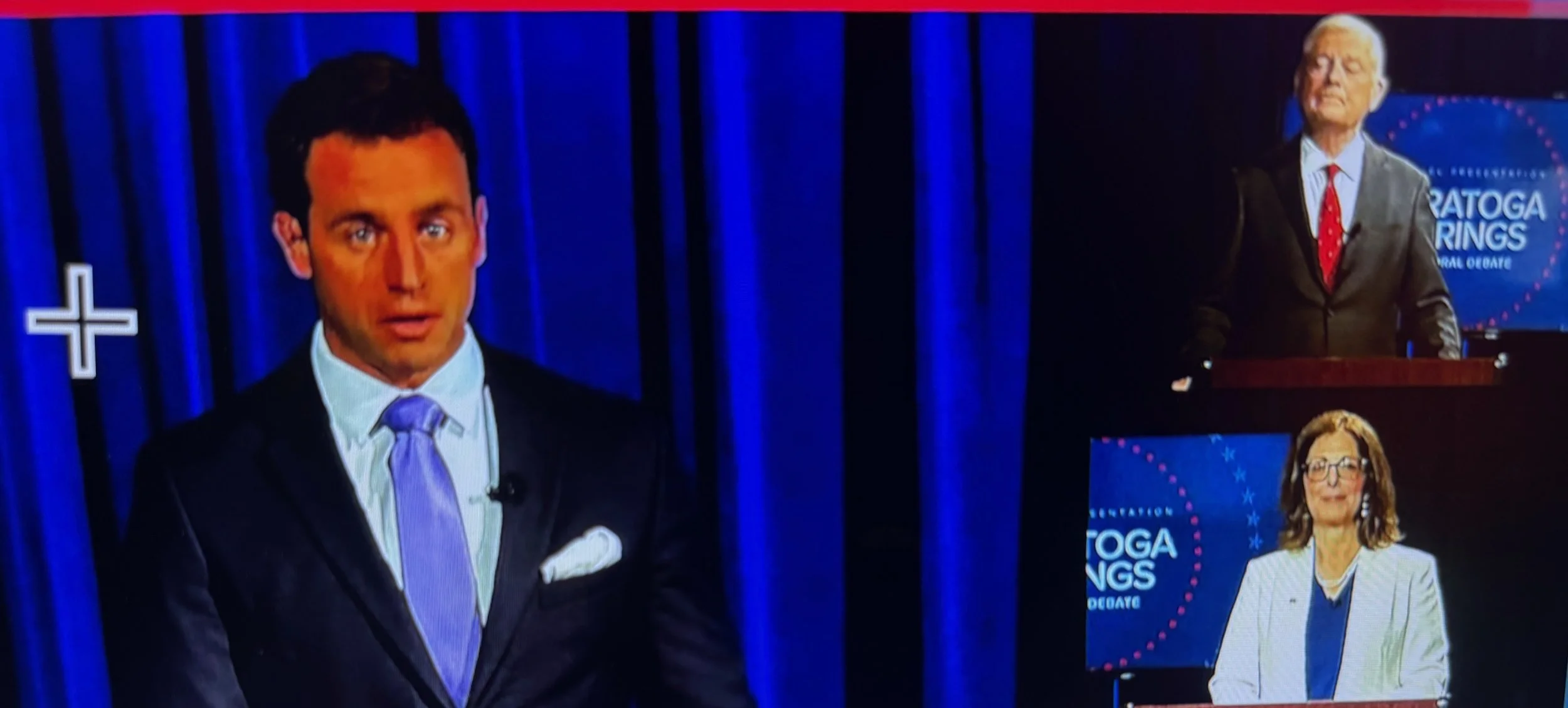Safford and Madigan Face Off
Curated by Dan Forbush in the Smartacus Neural Net
In a pivotal pre-election confrontation broadcast live by CBS 6, incumbent Republican Mayor John Safford and Democratic challenger Michele Madigan squared off in a closed studio, separated by just a few feet and a gulf of governing philosophy.
Moderated by Tom Eschen, the debate—without a live audience—offered a rare, tightly focused exchange that stripped away applause lines and partisan theatrics. What remained was a clear view of the choices facing Saratoga Springs voters: how to address homelessness, tackle the city’s housing crisis, and restore civility to a fractious City Hall.
CBS6 Reporter Tom Eschen moderated the 60-minute debate.
The stakes are high for a city at a crossroads—one celebrated for its prosperity but now confronting rising homelessness, soaring home prices, and growing divisions over public conduct and civic responsibility.
Safford, completing his first term as the city’s 23rd mayor, cast himself as the steady hand at the helm—a leader who has, in his words, “brought civility to City Hall” through a “fair, firm, and friendly” management style.
Madigan, currently a Saratoga County Supervisor and a former Commissioner of Finance for ten years, framed herself as the experienced reformer, emphasizing her record of fiscal discipline, debt refinancing that “saved taxpayers $6 million,” and a practical, compassionate approach to social policy. “I’m a mayor who can get things done,” she declared in her closing statement.
The Unhoused Population and the Camping Ordinance
The debate opened with the city’s most divisive issue: homelessness.
Comptroller data shows the number of unhoused individuals in Saratoga Springs more than doubled between 2022 and 2024, and the candidates’ opposing approaches could not have been sharper.
Safford described the problem as “serious and complicated,” noting his personal work with homeless veterans. He divided the city’s unhoused into three groups: those facing financial hardship, those struggling with addiction or mental illness, and a small number “who want to be so.” His chief concern, he said, was for “those who cannot help themselves.”
At the center of the dispute was the city’s new camping ordinance, passed over the summer. The measure allows police to fine individuals up to $250 for sitting or lying on public property.
Safford defended it unequivocally: “It’s working,” he said. “It gives us a tool to encourage people to get help.” He added that the city had “drawn a line in the sand”—a phrase that has since become shorthand for his administration’s approach to the crisis.
Madigan, however, rejected the ordinance as “the absolute wrong way” to address homelessness. She argued that it criminalizes poverty and undermines the success of existing programs like the Homeless Court and RISE Housing and Support Services, which she said boasts an 80% success rate in transitioning clients to stability.
“The city’s own judge is dismissing these cases,” Madigan said, noting that police have issued 31 warnings and 20 citations since August 1, none resulting in fines. She argued the ordinance gives judges no option for community service or service-based interventions. “Maybe five people are cycling through the system,” she said. “We should be helping them, not ticketing them.”
The exchange turned personal when Madigan accused Safford of supporting an “incarceration model” that would force the unhoused into rehabilitation through jail time. Safford shot back instantly: “That is a lie.” He insisted his ordinance included “no jail time,” while reminding viewers that Madigan herself voted in 2016 for an obstruction law that did. The moment crackled with the debate’s sharpest tension—a collision between moral language and municipal pragmatism.
Housing Affordability and Development
If homelessness defined the city’s moral challenge, housing affordability revealed its structural one.
With average home prices approaching $700,000, Madigan said the city is pricing out its essential workers—teachers, firefighters, and librarians—and losing the vitality of its neighborhoods.
She placed the blame on short-term rentals (STRs) owned by LLCs, which she said “overwhelm” residential districts and hollow out communities. Her prescription: expand accessory dwelling units (ADUs), seek state tax credits for municipalities to purchase land, and reform the Building and Planning Department, which she described as “overwhelmed” and slow to process applications. “People are waiting months, even years,” she said, “and that hurts everyone.”
Safford agreed that housing has become “unattainable for too many,” but pointed to tangible progress. He cited a partnership with the Saratoga Springs Housing Authority to reserve 40% of units in a new development near the railroad for workforce housing. His administration, he said, is also reviewing the Unified Development Ordinance (UDO) to identify zoning reforms that could accelerate construction. “We’re making progress,” he said. “But we need to do it the right way.”
NotebookLM is one of three essential AI tools I used in reporting this debate. It analyzed and organized the transcript I imported from Otter. I used ChatGPT to generate the content in a journalistic style.
City Finances and the Fund Balance Dispute
The debate’s most pointed exchange came over city finances—a subject that exposed not just policy differences but questions of competence and credibility.
Madigan portrayed the city’s financial position as sound, accusing Safford of misunderstanding key budget fundamentals. She repeatedly invoked a moment in a recent council meeting when, she claimed, the mayor asked, “What is fund balance?” “He doesn’t even know how much money the city has,” she said, arguing that the council is sitting on reserves it doesn’t seem to understand.
Safford, visibly irritated, insisted the question had been rhetorical, intended to clarify the concept for the public. “Having done over a hundred budgets for community associations,” he said, “I know what a fund balance is.” Still, he admitted to being “shocked” by the Finance Commissioner’s recent report recommending a hiring freeze and cuts to nonprofit grants, adding that “long-term projections have not been very good.”
The tension extended to the proposed $26 million police station.
Madigan said the city’s bonding capacity—restricted by the 2% Connolly amendment—wouldn’t support such a project. She proposed combining bonding, reserves (up to $5 million), and state aid to finance it.
Safford countered that the facility, built for 20 people but now housing 95, should have been replaced “a decade ago.” Both agreed the project was overdue; they differed only in how—and how fast—it should proceed.
Civility and Governance
If policy disputes revealed ideological divides, the question of civility exposed personal ones.
Safford has made “restoring civility” his signature achievement, claiming to have brought peace and stability to City Hall after years of public brawling. “Civility is the foundation of civilization,” he said. “It’s not just niceness—it’s mutual respect.” He credited his leadership with making meetings “peaceful, safe,” and functional again.
Madigan offered a reluctant concession—“the city is more civil than it was two years ago”—before challenging Safford’s methods. She accused him of failing to use the gavel to control unruly meetings and of having residents arrested during public comment sessions. One incident, she said, involved a woman detained after speaking for 40 minutes. “He talks about civility and harmony,” she said, “but doesn’t practice it.”
Safford dismissed the charge, saying his approach ensures order and safety, and that his “door is always open.” But the exchange underscored the subtext of the night: not just who could lead, but how.
Law Enforcement and Federal Agencies (ICE)
The debate’s brief detour into national politics came when the candidates were asked about Immigration and Customs Enforcement (ICE) activity in Saratoga Springs.
Madigan’s response was unequivocal: “I do not support ICE coming into our communities,” she said, citing the 14th Amendment’s due process clause and condemning the practice of agents “wearing masks, driving unmarked cars, and pulling people off the street.” She vowed to resist any cooperation with such operations: “Add my name to the list,” she said defiantly.
Safford framed the matter as a federal issue. “We have a legal obligation,” he said, explaining that ICE now coordinates with the city to “de-conflict” operations and avoid “blue-on-blue situations” where local and federal officers might overlap. He acknowledged sending a letter to Congressman Paul Tonko expressing concern about ICE’s methods but stood by the city’s cooperation as a matter of law and safety.
Tone and Dynamics
The tone of the evening oscillated between civility and confrontation, often within the same breath.
The absence of a live audience lent the debate a sense of intensity—each exchange echoing in the quiet of the studio. Eschen kept the pace brisk, his follow-ups sharpening rather than soothing the candidates’ differences.
The flashpoint came early, during the homelessness discussion, when Madigan accused Safford of favoring incarceration. “That is a lie,” Safford fired back, his voice rising for the first time. The moment crackled with political theater but also revealed the deep moral divide shaping the city’s discourse: punishment versus persuasion, order versus empathy.
Madigan repeatedly challenged Safford’s grasp of financial matters, while Safford dismissed her critiques as “political theater.” When she closed one rebuttal by citing the judge’s refusal to enforce fines under the camping ordinance, Safford muttered, audibly, “Doesn’t know what she’s talking about.”
If civility was the promise, the debate showed how difficult it remains to keep.
Takeaways and Implications
The debate clarified two competing visions for Saratoga Springs.
Mayor Safford presented himself as the guardian of order—a manager committed to stability, enforcement, and incremental reform. His philosophy is procedural: set boundaries, enforce laws, and restore decorum.
Michele Madigan positioned herself as the seasoned reformer, promising compassion backed by competence. Her platform emphasizes service-based solutions for the unhoused, aggressive pursuit of workforce housing, and a confident command of the city’s finances.
Their clash was less about partisan ideology than about temperament and governance style. One leads with structure; the other with empathy.
For Saratoga Springs voters, the choice in November may hinge on which kind of leadership they believe the moment requires:
a mayor who draws clear lines in the sand—or one determined to erase them, and start again.



